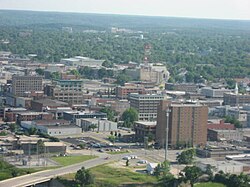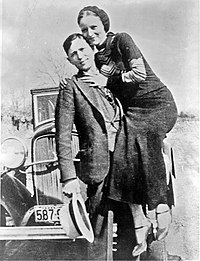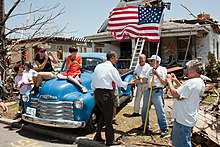From Wikipedia, the free encyclopedia
| Joplin, Missouri | |
|---|---|
| City | |

Aerial view of downtown Joplin, 2009. The bridge is 2nd Street and the intersection is 2nd St. and Virginia Ave.
|
|
| Motto: "Proud of Our Past...Shaping Our Future'" | |
 Location in the state of Missouri |
|
| Coordinates: 37°5′3″N 94°30′47″WCoordinates: 37°5′3″N 94°30′47″W | |
| Country | United States |
| State | Missouri |
| Counties | Jasper, Newton |
| Incorporated | 1873 |
| Government | |
| • Mayor | Michael Seibert |
| Area[1] | |
| • Total | 35.68 sq mi (92.41 km2) |
| • Land | 35.56 sq mi (92.10 km2) |
| • Water | 0.12 sq mi (0.31 km2) |
| Elevation | 1,004 ft (306 m) |
| Population (2010)[2] | |
| • Total | 50,150 |
| • Estimate (2014[3]) | 51,316 |
| • Density | 1,410.3/sq mi (544.5/km2) |
| Time zone | CST (UTC-6) |
| • Summer (DST) | CDT (UTC-5) |
| ZIP codes | 64801-64804 |
| Area code(s) | 417 |
| FIPS code | 29-37592[4] |
| GNIS feature ID | 0729911[5] |
| Website | JoplinMO.org |
History
19th century
Main Street, below 5th Street c. 1910
The Carthage resident Patrick Murphy filed a plan for a city on the opposite side of the valley and named it Murphysburg.[10] While the nearest sheriff was in Carthage, frontier lawlessness abounded in Joplin. The historic period was referred to as the "Reign of Terror." The cities eventually merged into Union City, but when the merger was found illegal, the two cities split. Murphy suggested that a combined city be named Joplin. The cities merged again on March 23, 1873, this time permanently, as the City of Joplin.[11]
While Joplin was first settled for lead mining, zinc, often referred to as "jack," was the most important mineral resource. As railroads were built to connect Joplin to major markets in other cities, it was on the verge of dramatic growth. By the start of the 20th Century, the city was becoming a regional metropolis. Construction centered around Main Street, with many bars, hotels, and fine homes nearby. Joplin's three-story "House of Lords" was its most famous saloon, with a bar and restaurant on the first floor, gambling on the second and a brothel on the third. Trolley and rail lines made Joplin the hub of southwest Missouri. As the center of the "Tri-state district", it soon became the lead and zinc mining capital of the world.
As a result of extensive surface and deep mining, Joplin is dotted with open pit mines and mine shafts. Mining left many tailings piles (small hills of ground rock), which are considered unsightly locally. The open pit mines pose both hazards, but some find them to have a kind of beauty as well. The main part of Joplin is nearly 75% undermined, with some mine shafts well over 100 ft (30m) deep. These mine shafts have occasionally caved in, creating sink holes. The mining history and geology are well documented in the mineral museum in town.
20th century
Panorama of Joplin, circa 1910
Bonnie & Clyde, photo developed by the Joplin Globe after the shoot out.
After World War II, most of the mines were closed, and population growth leveled off. The main road through Joplin running east and west was designated as part of U.S. Route 66, which became famous as more Americans took to newly constructed highways. The roads provided improved access between cities, but they also drew off population to newer housing and eventually retail centers.
In the 1960s and 1970s, nearly 40 acres (16 hectares) of the city's downtown were razed in an attempt at urban renewal, as population and businesses had moved to a suburban fringe along newly constructed highways. The Keystone hotel and Worth Block (former home of the House of Lords) were notable historic structures that were demolished. Christman's Department Store stands (converted into loft apartments), as does the Joplin Union Depot, since railroad restructuring and the decline in passenger traffic led to its closure. Other notable historic structures in Joplin include the Carnegie Library, Fred and Red's Diner, the Frisco Depot, the Scottish Rite Cathedral, and the Crystal Cave (filled in and used for a parking lot). The Newman Mercantile Store has been adapted for use as City Hall. The Fox Theatre has been adapted for use as the Central Christian Center.[citation needed]
On May 5, 1971, Joplin was struck by a severe tornado, resulting in one death and 50 injuries, along with major damage to many houses and businesses.[13]
Historic district at 6th and Main, looking north, 2010.
21st century
The city has two major hospitals which serve the Four States region, Freeman Hospital West and Mercy Hospital -- Joplin, the latter replacing St. John's Regional Medical Center which was destroyed in the May 22, 2011 tornado. Freeman Hospital East and Landmark Hospital serve more specialized community health needs. The city's park system has nearly 1,000 acres and includes a golf course, three swimming pools, 15 miles of walking/biking trails, the world's largest remaining globally unique Chert Glades and Missouri's first Audubon Nature Center located in Wildcat Park. A waterfall, Grand Falls, the highest continuously flowing in the state, is on Shoal Creek on the southern end of the city. Included in Schifferdecker Park is the Everett J. Ritchie Tri-State Mineral Museum and Dorothea B. Hoover Historical Museum, which holds a significant collection of minerals from the era of lead and zinc mining in the region.Numerous buildings in Joplin have been listed on the National Register of Historic Places for their historic and architectural significance.[14] Recently[when?], the city has undertaken a major project to revitalize its Main Street downtown district, which lies on the historic Route 66. It has refurbished building facades, sidewalks, and added old-styled lamp posts, flower baskets, and benches to highlight the historic center of the city. A gasoline powered citywide trolley system evokes images of the towns vibrant past.
Numerous trucking lines such as CFI (now Con-Way Truckload) are headquartered in town, as the city is situated near the geographic and population centers of the nation. Eagle-Picher Industries, TAMKO Building Products, AT&T Communications and FAG Bearings are noted employers in Joplin, and Leggett & Platt (Fortune 500) is located in nearby Carthage. The city is served by the Joplin Regional Airport located in the north of town near Webb City.
In the 1990s, the city continued to expand eastward toward I-44. Large-scale development occurred along Range Line Road, particularly around Northpark Mall. Numerous suburbs adjacent to the city include Carl Junction, Duquesne, Airport Drive, Oronogo, Carterville, Redings Mill, Shoal Creek Drive, Leawood, and Saginaw.
Due to its location near two major highways and its many event and sports facilities, Joplin attracts travelers and is a destination for conferences and group events. Joplin offers nearly 2,500 hotel rooms, the majority located within a 1/4-mile area of Range Line Road and I-44. It has the 30,000-square-foot (2,800 m2) John Q. Hammons Convention and Trade Center, which serves as the primary event facility for conventions, associations, and large events.
Each June, Joplin hosts the Boomtown Run, a half marathon, 5K and children's run. The event attracts runners from across the country, and features USTA certified courses which start and end in the historic downtown area. Celebrity runners featured at the pre-race banquet have included Bart Yasso, Sarah Reinerston, Suzy Favor-Hamilton and Jeff Galloway. In 2011, due to the devastating EF-5 tornado that struck Joplin on May 22, just three weeks before the run, the event was transformed in the Boomtown Run Day of Service. More than 270 individuals registered for the race after the tornado struck, knowing their proceeds would benefit tornado recovery. On June 11, approximately 320 registered runners and volunteers turned out to help clean debris and sort donations, contributing more than 1,200 hours of service. On August 7, 2012, The Village of Silver Creek and the City of Joplin, voted to have Silver Creek annexed into Joplin City limits.
2011 tornado
President Obama greets Hugh Hills, 85, in front of his home on May 29,
2011. Hills hid in a closet during the tornado, which destroyed the
second floor and half the first floor of his house.
See also: 2011 Joplin tornado
On May 22, 2011, an EF-5 tornado
first touched down near the western edge of the city among large, newer
homes, at about 5:21 pm CDT (22:34 UTC) and tracked eastward across the
city and across Interstate 44 into rural portions of Newton and Lawrence
counties. Its track was reported to have been about 0.75 miles
(1.21 km) in width and 22.1 miles (35.6 km) long. About 8,400 houses,
18,000 cars, and 450 businesses were flattened or blown away in Joplin,
particularly in the section between 13th and 32nd streets across the
southern part of the city. The tornado narrowly missed the downtown
area. St. John's Regional Medical Center
was destroyed and demolished in 2012. The Missouri Disaster Medical
Assistance Team (DMAT) temporarily replaced the demolished St. John's
Regional Medical Center with a mobile hospital[15]
until the permanent hospital was rebuilt. The local high school, Joplin
High School was totally destroyed as well. A total of 161 people died
from tornado-related injuries as of the end of July 2011. The Weather Channel video showed entire neighborhoods flattened. Communications were lost and power was knocked out to many areas.[16] An official statement from the National Weather Service has categorized the Joplin tornado as an EF5.[17][18][19][20] On Sunday, May 29, 2011, President Barack Obama, Missouri Governor Jay Nixon, and Federal Emergency Management Agency Director Craig Fugate
visited and toured Joplin to see what the damage looked like and
attended a memorial service for the deceased. Later that day, the city
held a moment of silence at 5:41 pm, to mark the time the tornado
struck. The area was declared a federal disaster area.In July 2011, the City of Joplin entered into a contractual agreement with Wallace Bajjali Development Partners, L.P., a master developer company out of Sugar Land, Texas, hired to assist in nearly $800 million in reconstruction efforts over the next five years. Priority construction projects include residential districts and senior and assisted living facilities; 7,500 residential dwellings in the City were damaged or destroyed by storm. Approved by the citizens, additional projects intended to spur expansion and economic growth include the construction of a $40 million performing and cultural arts center, a new and expanded public library and theatre facility, renovation of the historic downtown Union Depot, and a consolidated post office and state government complex, among other city amenities of trails, sidewalks, transportation and park enhancements. A variety of additional major projects will follow, greatly enhancing and expanding all aspects of the community's development. City Manager Mark Rohr said that "this effort is the greatest opportunity the city has ever seen." Among other resources and support from governmental agencies, the Federal Economic Development Administration provided $20 million to construct a new Joplin Library and a two-year funding agreement to hire a disaster recovery coordinator to help coordinate the city's nearly $850 million in immediate restoration and recovery efforts.[21] In the summer of 2012, the federal Housing and Urban Development Department awarded a $45 million Community Development Block Grant for reconstruction efforts and in 2013 awarded another $113 million.[22][23] In May 2013, the Missouri Department of Natural Resources awarded Wildcat Glades Conservation & Audubon Center $500,000 for help with the restoration of the urban forest, which was passed through to the City of Joplin as a subgrant. 1,500 large-caliper trees were planted in the tornado zone and along an urban stream, Joplin Creek.[24]
Government
Local government for the City of Joplin is provided through a nine-member City Council, whose members are elected by voters citywide, with four seats being assigned to designated geographic zones of the city. City Council members include the city's mayor, who is responsible for serving as meeting chair and official spokesman for the City Council; and the mayor pro tem, who is responsible for performing the mayor's duties in the latter's absence. Both positions are elected every two years by their fellow council members.[25]Following the April 2014 city elections, the City Council members included:
- Michael Seibert (Mayor)
- Morris Glaze (Mayor Pro Tem)
- Melodee Colbert-Kean
- Bill Scearce
- Miranda Lewis






a place to go.
ReplyDeleteI don’t know how should I give you thanks! I am totally stunned by your article. You saved my time. Thanks a million for sharing this article.
ReplyDelete